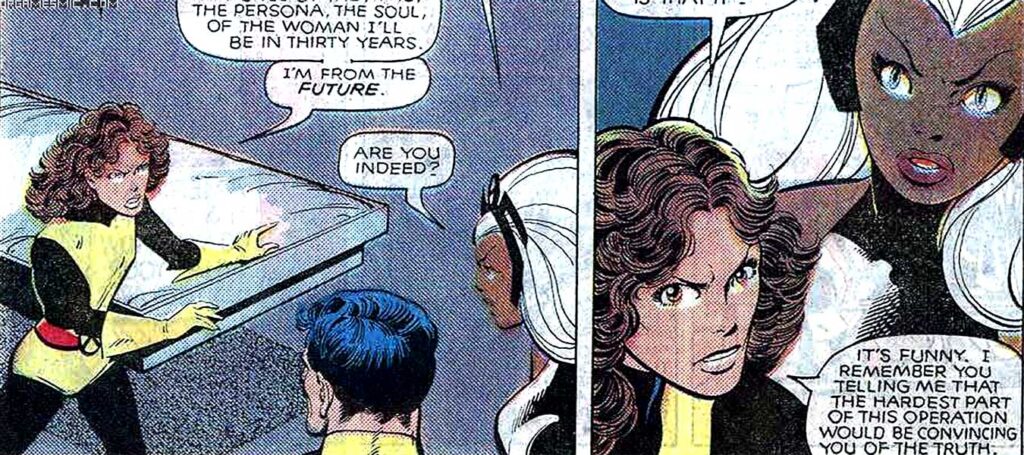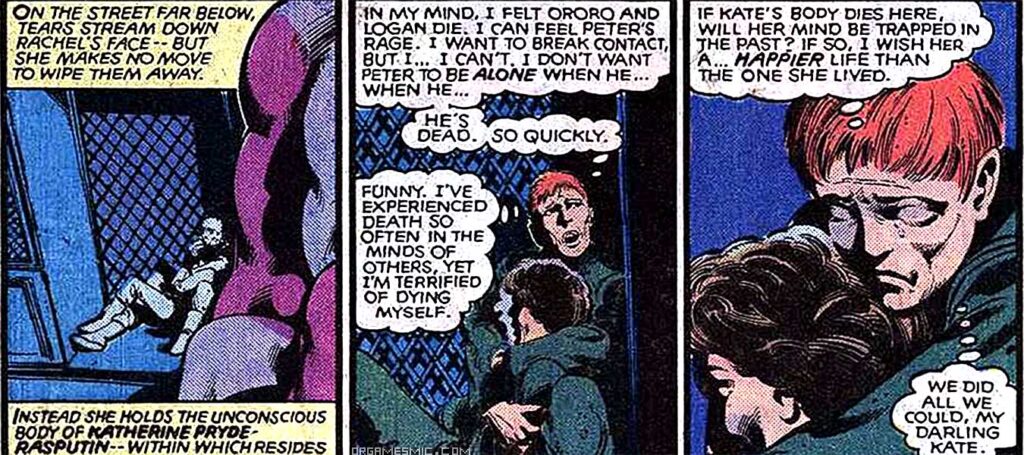This page may contain one or more affiliate links, which means that if you purchase a product through that link, I may receive compensation. The links will be identified with the text "affiliate link". Click to learn more.
Imagine your race being eradicated to near extinction by giant robots, and countries being so afraid of these robots that your home will soon be victim to a nuclear holocaust. This happens in one of the best X-Men comic book story arcs called Days of Future Past. Not only is it a powerful story about the survival of the mutant race, but all of humanity as well. X-Men member Kitty Pryde in the year 2013 has her mind psychically projected into the past in order to change history. Written and drawn by the famous X-Men team Chris Claremont and John Byrne, the lasting impact of this story only strengthens the reputation of these star comic creators.
At its core, Days of Future Past is a cautionary tale about the dangers of discrimination and the consequences of unchecked hatred. In this alternate future, humans have turned against mutants, viewing them as a threat to their existence. As a result, mutants are forced into internment camps, where they are subject to inhumane treatment and constant fear. It is a bleak and terrifying world, one that serves as a stark reminder of the dark side of humanity. But amidst this chaos and destruction, there is still hope in the form of Kate Pryde as she time travels, and must face the harsh reality of the past and the difficult decisions that led to this dystopian future.
It is such an iconic story in comics that it had been adapted into a two-part animated story, a live-action movie, and an audiobook. Although all three variations keep the general premise of the story intact, nothing comes close to touching the original comic book. To see and feel the tragedy and desperate fight for survival yourself, you need to read Uncanny X-Men 141 and 142. Here is a summary of the two comics so that you can understand the major parts of the story.
Kitty Pryde’s Dangerous Quest For Survival

To understand the plot, we have to start at the beginning. At one point, one of X-Men’s newest and youngest recruits was Kitty Pryde. Her nickname, Sprite, would change to Kate by the time she was 35, and by then would be a grown woman married to Peter Rasputin, better known as Colossus. We know this because The first part of this story shows us her tragic future.
The story begins with her as Kate walking through the destroyed remains of New York City. She is wearing an inhibitor collar that keeps her from using her powers. Kate was able to temporarily leave her mutant camp so that she could do Sentinel duty work. The Sentinels are robot mutant hunters that capture and kill mutants. Some of the mutants are kept alive so they can perform certain tasks, which is the case for Kate.
While away from the camp, she meets up with Wolverine, who is part of the Canadian Resistance Army. After helping Kate escape a gang of mutant haters, he gives her a component of a signal jammer that, while back at the camp, will block the signal from the inhibitor collars, allowing them to be removed. Kate returns to The South Bronx Mutant Internment Center, but not before being interrogated by a Sentinel about why she was off schedule and arrived back late. She explains that she was jumped by some gang members, called Rogues, and the Sentinel analyzes her brain using an encephalo scan to conclude that she’s telling the truth. The story continues to say that Kate went through an exhaustive and intentionally humiliating security examination to make sure that she didn’t have contraband. (Probably a strip-search. But how did she smuggle the component in?)

The camp that she lives in, along with the other mutants, is full of graves to show all the people who had been executed. Some of them are X-Men, such as Scott Summers (Cyclops), but others are members of The Fantastic Four. In fact, all four original members are dead, except for Susan and Richard’s future son Franklin Richards. (Later in the story, we find out that The Fantastic Four’s former headquarters, The Baxter Building, is the headquarters of The Sentinels.)
All the mutants are branded with an M on their jumpsuits, exiled from their homes and forced to live in the camp. It’s not hard to compare this mass mutant genocide to The Holocaust of 1941. Thanks to the signal jammer Wolverine helped them build, their inhibitor collars have been removed, and they are able to use their mutant powers again. With the help of a psychic named Rachel, Kate’s mind is about to be projected to the day the trouble started.
Traveling to the Past

The story continues in a dramatic way. In the year 2013, Kate’s adult mind is swapped out with her own teenage mind to October 31st, 1980. This is the day that Senator Robert Kelly is going to be assassinated by the group of mutants lead by the villain Mystique. This event is the central moment for the storyline that creates a dystopian future.
While Kitty is going through her very first exercise in Danger Room as a young recruit, she suddenly passes out. When she wakes up, she is her future self’s mind, Kate, in her younger body from the past. She quickly tries to explain herself and what has happened to The X-Men standing around her.
Kitty explains to The X-Men that not only does the presidential candidate Senator Kelly get killed, but so does Professor Xavier and Dr Moira MacTaggert. Giant Sentinel robots, designed to kill mutants, decide that the best way to eliminate the threat is to take over the country. Kitty goes on to explain that all super beings, hero or villain, are targeted and executed by The Sentinels. Other countries decide on an automatic nuclear strike on America the moment The Sentinels leave the country.

Storm especially doesn’t believe her and thinks that she may have had a concussion or something. But Wolverine senses something is very different. He notices that she looks like a kid, but she stands, talks and moves like a woman. Storm agrees for everyone to go to Washington so see Professor Xavier.
Mystique’s group of evil mutants disrupt the conference in Washington, DC. The X-Men defeat them, except for one. Kitty finds the blind precognitive named Destiny with a crossbow pointed at Senator Kelly. Kitty’s “time-switch” had managed to make her invisible to Destiny’s prescient abilities. She thwarts the attack against Kelly, which results immediately in the mind-swap reversing itself. Kitty’s 13-year-old mind returns, and she remembers nothing since being in The Danger Room.
During The Future

While these positive changes in the story were taking place in the past, the future continued to look bleak. While Kitty (with Kate’s mind) had been trying to change the past, her body in the future remains unconscious and is carried by Colossus. Wolverine, Storm and Colossus travel through old subway tunnels to reach The Baxter Building serving as The Sentinels’ headquarters.
After using The Fantastic Four’s personal elevator (because the building used to belong to them), the remaining X-Men find the key Sentinel maintaining the controls. However, the Sentinel turns around and kills Wolverine with a deadly blast before he can achieve his goal. (This will not be the only time when Wolverine dies.) The machine states that they were allowed into the building to make it more efficient to kill them. They failed.
In the doorway of a building, the psychic Rachel Summers who switched Kitty’s mind holds her unconscious body, which still contains her mind and soul, close to her chest. She knows that Wolverine and Storm died, due to her mental abilities. She sheds a tear and mentally tells Kate that they did all they could, and now it’s up to her in the past to change the future.
Movie Adaptation

The movie adaptation, called X-Men: Days of Future Past, has the same dystopian future of genocide and oppression as the comic book. However, nearly all key elements had been changed and it’s hardily the same story. Instead of Kitty Pryde being mind-swapped into the past, it was Wolverine. The Sentinels, rather than being giant robots, are more like organic machines that can adapt to any mutant abilities or attacks that they encounter.
Instead of Mystique killing the mutant-hater Senator Robert Kelly, she kills Dr Bolivar Trask who created the Sentinels’ technology. (Senator Kelly died in the first X-Men movie, so obviously this plot point had to be changed.) Meanwhile, Professor Charles Xavier is depressed and is taking anti-mutant serum to suppress his powers (which is rather ironic, considering the comic book story’s inhibitor collars) and Magneto is in a concrete prison underneath The Pentagon.
Much of the cast in the movie were recast from X-Men: First Class. Jennifer Lawrence was one of them, which her X-Men casting predated Hunger Games. Dr Bolivad Trask is played by Peter Dinklage from Game of Thrones fame.
Hugh Jackman, who stands at 6’3″ according to Wikipedia, is literally a foot taller than the Wolverine character as depicted in the comic books. Since first starring as the character, his fame skyrocketed, and was named Sexiest Man Alive in 2008, so it’s not hard to see why his character replaced Kitty Pryde as the main protagonist.
James McAvoy, cast as the younger version of Charles Xavier, was already an established actor with a number of critically acclaimed roles under his belt. However, his casting might have been influenced by his youthful image and the potential to attract a younger demographic to the franchise. Similarly, Michael Fassbender was chosen for the role of Magneto, a decision that seemed to be driven more by his rising star status than by how well he suited the character. Fassbender was undeniably talented, but some found his portrayal of Magneto to be too far removed from the original character as envisioned in the original comic issues.
These casting decisions, arguably made for their potential to boost box office revenues, may have contributed to the deviation of the characters from their comic book origins. That being said, the past films may have made it impossible to follow the same timeline as the comics, leading to changes like Wolverine going back in time instead of Kitty.
Audio Book Adaptation
Believe it or not, there is an audio version of this story. Sounds like fun until you find out that they decided to embellish a little too much. The comic version is merely two issues, yet manages to convey everything that you would like to know about the story wrapped into a fun little tale. The same can’t be said about the audio version, which had been padded with fabricated parts of the story that never existed in its original source material.
One of the most notable differences is that when Kitty’s mind is swapped with her future self’s mind, she gets to experience the future. In the original story, Kitty’s mind remains dormant in her unconscious body from the future. The audiobook version, alternatively, has detailed descriptions of Kitty’s thoughts and experiences while in the future. She finds out that she’s married to Colossus, for example. A story the length of two comic books had been somehow stretched to almost five hours. Key elements of the story had been changed too, including the ending. Although the reasons are obvious to extend the story, fabricating and alternating key parts of it feels like a violation for those who hadn’t read the comic version yet.
Grab one of the many graphic novel reprints. (Affiliate link.) That way, you can read the story first-hand.

